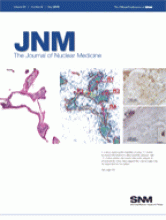TO THE EDITOR: 18F-fluoride PET has reemerged as a genuine clinical alternative to 99mTc-diphosphonate scintigraphy. In vivo, NaF dissociates into its salts Na+ and F− (fluoride). Fluoride is exchanged with OH− (hydroxyl) ion in the hydroxyapatite matrix of the bone before migrating into the crystalline matrix (1). Approximately 50% of the injected dose localizes in bone, and bone retention of fluoride continues until bone remodeling (1). Fluoride has minimal protein binding affinity, allowing more rapid excretion of the fraction not localized in bone and favoring earlier postadministration imaging and low background activity (1). Elevation in plasma concentrations of unlabeled fluoride may reduce 18F-fluoride uptake because of competition. In vivo competition is likely to increase the ratio of 18F-fluoride excreted to 18F-fluoride bound in bone, decreasing the percentage of the injected dose localizing in the bone. The effects on image quality may include a decrease in target organ count density and an increase in renal and bladder activity. The implications might be even more crucial for quantitation of fluoride bone uptake.
There are several fluoridated hydrocarbon-based general anesthetics that are metabolized to produce fluoride ion, which should be considered a potential confounder of 18F-fluoride bone uptake. Of the fluoridated ethers, the most frequently used inhaled anesthetic agents in developed countries are enflurane, isoflurane, desflurane, and sevoflurane (2). Enflurane (Ethrane; Abbot Laboratories) has 2%−8% oxidative metabolism in the liver to produce fluoride ions to plasma levels as high as 20–40 μM (3). Sevoflurane (Ultane; Abbott Laboratories) has about 1%−5% liver metabolism, with one of the by-products being fluoride ions (3,4). Plasma fluoride concentrations in excess of 50 μM are produced; more than 50 μM is associated with renal impairment (4). Both enflurane and sevoflurane show serum fluoride ion levels peaking soon after completion of surgery (cessation of anesthetic delivery) (2,3). Nonetheless, elevated serum fluoride ion levels are high beyond 24 h. The retention of high serum levels after cessation of anesthesia is likely to represent saturation of fluoride on bone and reverse exchange from the bone surface to blood once blood concentration falls below that of bone. The implication for 18F-fluoride PET is that significantly less than the usual 50% of the injected dose may localize to bone if enflurane or sevoflurane anesthesia has been used in the previous 24–36 h—perhaps longer for prolonged general anesthesia or in those with renal impairment.
Although potential competitive interaction between 18F-fluoride and the by-products of inhalation anesthetics may decrease image quality, of greater importance is the potential impact of this competition on bone uptake quantitation. Further qualitative and quantitative research should be undertaken to determine the relationship and time course of interaction between fluoride ion–producing inhalation anesthetics and 18F-fluoride PET image quality.
Footnotes
-
COPYRIGHT © 2010 by the Society of Nuclear Medicine, Inc.







